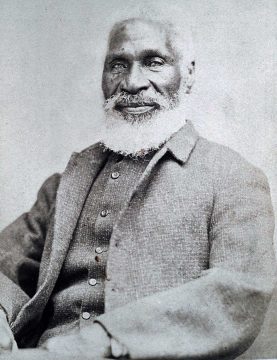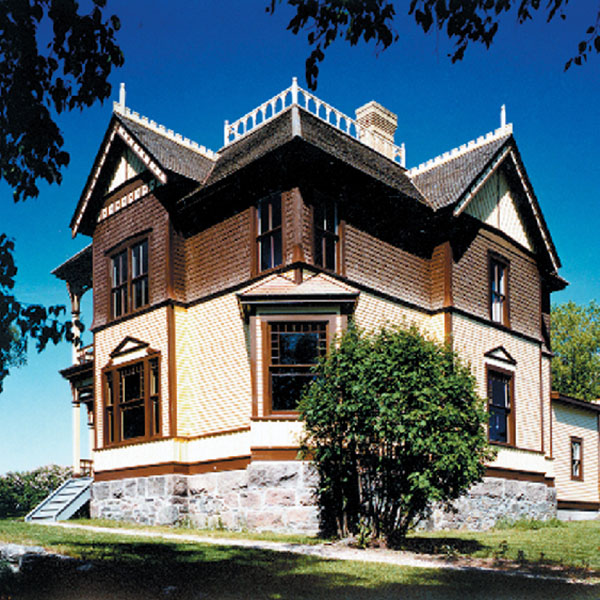Menu
While the museum is now closed for the season, we are still open for groups of 15 or more by appointment.
“It has been spread abroad that ‘Uncle Tom' is coming, and that is what has brought you here. Now allow me to say that my name is not Tom, and never was Tom, and that I do not want to have any other name inserted in the newspapers for me than my own. My name is Josiah Henson, always was, and always will be.” Josiah Henson, Glasgow, Scotland, 1877 (from Uncle Tom’s Story of His Life)
Uncle Tom’s Cabin Historic Site has changed its name.
In recent years, the Trust has conducted a focused review of its properties and programming. New research and the openness to diverse perspectives help to broaden our understanding of Ontario’s heritage, including the evolution of terminology.
The Trust recognizes the power of words in conveying emotions, values and memories. The term "Uncle Tom" carries several destructive stereotypes and harmful connotations that diminish and detract from Josiah Henson’s significant contributions to African-Canadian heritage and the broader Black community.
The term “Uncle Tom” is used in social media, television, movies and literature as a means of insulting and demeaning a person of Black heritage. It implies that a person of African descent is a traitor to their race and, as such, the phrase is perceived as pejorative and harmful, despite Harriet Beecher Stowe’s intentions in the creation of her literary character. To continue to use this term in association with Josiah Henson does a disservice to his legacy. Henson worked with energy and vision to improve life for the Black community in Ontario. By remembering him as Uncle Tom has, in some ways, diminished his status and accomplishments.
From its inception as a small Ontario tourist attraction in the 1940s to its status as a hub for Black recognition and accomplishment, the museum property and programming has continually evolved. Join us on this ongoing journey to freedom!
Here, you can better understand the evolution of the museum and its close association with the term “Uncle Tom.”
Stowe's Uncle Tom
Uncle Tom is the protagonist of Harriet Beecher Stowe’s 1852 anti-slavery novel, Uncle Tom’s Cabin. Her portrayal of Tom was that of a stoic, noble character who humanized the suffering and hardships of enslaved people of African descent for its readers. In Stowe’s novel, the Tom character is presented as a virtuous figure, guided by his religious conviction of non-violence. Tom exhibits compassion and empathy despite the cruel treatment of his enslavers. He is portrayed as a leader and protector of those with whom he is enslaved, caring for them when they are injured or ill, and offering spiritual guidance to those whose own resolve weakens under the oppressive institution of slavery.
The trials that Tom endures throughout the novel are a testament to Stowe’s original vision for a sympathetic Black character that would bring attention to the mistreatment and dehumanization of enslaved people of African descent. Although Stowe's intent was to portray Tom as a symbol of strength, goodness and leadership, the negative connotation associated with Uncle Tom quickly shifted the way that he was perceived.
Becoming Uncle Tom
Henson's autobiography – The Life of Josiah Henson, formerly a Slave, Now an Inhabitant of Canada, as Narrated by Himself – was published in 1849. When southern plantation owners accused Harriet Beecher Stowe of misrepresenting slavery in her novel, she published, in 1853, Key to Uncle Tom’s Cabin, Presenting the Original Facts and Documents upon Which the Story Is Founded, Together with Corroborative Statements Verifying the Truth. It was here that Stowe quoted extensively from Henson’s autobiography in the defence of her novel.
Henson's autobiography was expanded and republished in 1858 under the title Truth Stranger Than Fiction: Father Henson's Story of His Own Life. This edition contained a foreword by Harriet Beecher Stowe, which reinforced the public’s perception of Henson as the model for the character of Uncle Tom in her novel, Uncle Tom’s Cabin.
Henson rose to international prominence after Harriet Beecher Stowe acknowledged his memoirs as a source for her novel.
The Rise of Uncle Tom-ism
Minstrel shows developed in the United States in the 19th century as a form of stage entertainment but were popular across Canada and Europe as well. They showcased negative racial stereotypes with white performers putting on black face (darkening their skin with burnt cork or shoe polish) and performing racist songs, dances and comedy routines. Read more about the history of black face and minstrel shows in Canada.
Following the release of Harriet Beecher Stowe‘s internationally bestselling novel, minstrel show versions of Uncle Tom’s Cabin began popping up throughout North America and Europe as a response to the anger and embarrassment caused by Stowe’s depiction of plantation slavery.
These “anti-Tom” shows saw the central character of Tom transformed from that of a saintly figure to a fawning, docile and self-loathing yes-man, known for singing, dancing and smiling despite his dire circumstances. These performances sought to obscure the violence and inhumanity of the institution of slavery. “Tom shows” played for over 80 years before they finally died out in the 1930s, but their harmful legacy remains to this day.
Now, the term is used as an insult. It references a person of African descent who is considered a traitor to their race by seeking approval and attention from white people.
Preserving Henson's legacy
The house in which Josiah Henson spent the latter days of his life was first opened to the public as a tourist attraction in 1948 by then-property owner William Chapple, who named it “Uncle Tom’s Cabin.” The house was later sold to Jack Thomson, who moved the structure and two other period buildings to their present location in 1964 with the goal of starting a museum. Thomson named the museum “Uncle Tom’s Cabin and Museum” after the novel Uncle Tom’s Cabin; or, Life Among the Lowly by Harriet Beecher Stowe, in which the character Tom was loosely based on the life of Josiah Henson.
In 1984, the site was sold to the County of Kent who transferred it to the St. Clair Parks Commission in 1992. In 1993 and 1994, the historical site underwent extensive upgrades and restoration of the three period structures, and the Josiah Henson Interpretive Centre was built, followed by a rededication ceremony in 1995. The site was renamed Uncle Tom’s Cabin Historic Site at this time. The property and buildings were transferred to the Ontario Heritage Trust in 2005.
Although discussions of a name change have happened since the early 1990s, the St. Clair Parks Commission, which managed the site at that time, in consultation with the Uncle Tom’s Cabin Historic Site Advisory Board, felt that the museum had a positive association with visitors from around the world who had studied the anti-slavery novel Uncle Tom's Cabin. More recently, the Trust has attempted to reclaim the phrase as it aligns with the anti-slavery movement and the fight against slavery. Through greater understanding of Canada’s role in systemic anti-Black racism, it is recognized that it is necessary to carve a path forward that is more equitable and just and it is the time to revisit the name “Uncle Tom’s Cabin Historic Site.”
Reclaiming Josiah Henson
Approaching his 80th birthday , Josiah Henson reflected on his life from a pulpit in Glasgow, Scotland as part of his tour of the United Kingdom. Once again, he was introduced to the thousands in attendance through his association with Stowe’s literary creation. It was his desire, however, to be acknowledged for his life’s remarkable achievements – as a conductor of the Underground Railroad and a force in the abolition movement, as an educator and co-founder of the British American Institute, as the author of his memoirs, which put Canada on the map as a safe haven for refugees from slavery, and as a preacher, husband and father.
The Ontario Heritage Trust strives to ensure that the heritage we protect and the stories we tell are respectful, accurate and authentic representations of the peoples who have lived on this land.
Much like the stories of other Blacks and African Canadians who have been obscured over time, the achievements of Josiah Henson have also been diminished. Separating Henson’s identity from the literary character of Uncle Tom allows us to reclaim the legacy of his life’s work and acknowledge the importance of this work in building an anti-racist and inclusive Ontario.
Photo gallery
-

Credit: Josiah Henson (Photo: Schlesinger Library, Harvard University) -

Credit: Curator Jack Thomson at Uncle Tom’s Cabin and Museum gift shop entrance. (Source: Josiah Henson Museum of African-Canadian History archives) -

Credit: Father Henson's Story of His Own Life; 1858 edition of Josiah Henson's autobiography, with an introduction by Harriet Beecher Stowe. (Source: Josiah Henson Museum of African-Canadian History archives) -

Credit: Uncle Tom's Cabin, Young Folks Edition. (Source: Josiah Henson Museum of African-Canadian History archives)







